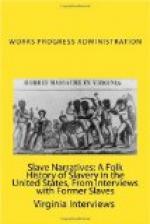Among some of the old wills compiled by Dr. George F. Doyle of Winchester, we find wills as follows:
“John Briston in his will dated April 27, 1840 frees his negroes, the executor to go to Todd County and buy land and divide it between the negroes and they were given a cow, three horses and he expressed a desire for them to go to Liberia. They were to be given a certain amount to defray their moving expenses, and buy them provisions and each negro was given his blanket.”
“Henry Calmes, in his will dated 1831, divides his slaves among his wife and children.” (B7—p654)
“John Christy in his will 1848 says at the death of his wife all his land and slaves are to be sold and the proceeds divided among his children.” (B11—p346).
“In some old wills enough slaves are to be sold said all outstanding debts paid and those left to be divided among his heirs.”
“A will dated 1837 says at the expiration of eight years after his death all negroes above those bequeated are to be offered to the Colonization Society, if they are of age, to be transported to Liberia and those not of age to continue to serve the persons to whom they are allotted until they come of age, boys 21 and the girls at 18 when they are to be offered to the Colonization Society to be transported to Liberia. None of them are to be forced to go. Those that do not go to Liberia are to continue to serve the persons to whom they are allotted until they are willing to go. Three persons by name to be hired out the seventh year after the death and the money arising from said hire to be given to those that first go to Liberia, $10.00 a piece if there should be so much and the balance given to the next ones to go.”
“In the will of Robert Lewis, February 20, 1799, he sets three of his slaves free and gives them the use of 200 acres of the northwest of the Ohio, their life time. There were to be five hired out until their hire amounts to 120 pounds each, then they were to be freed. As the other younger slaves become of age, they are to be freed.”
From the following will dated June 22, 1840 it shows the slaves were able, to accumalate an estate:
“Allan, Charles June 22, 1840 Oct 26, 1840
“A free man of color. Estate to be sold and the proceeds distributed as follows: To Ester Graves, a woman of color belonging to the heirs of Rice Arnold, $100.00; balance of money to be divided equally between the children ‘I claim to be mine’. Jerrett, Charles, Ester, Carolina, Granvill and Emile; all children of aforesaid. Charlotte Arnold and all belonging to the heirs of Rice Arnold and also Sally, Alfred, Mary, Lucy, Hulda, Catharine, and Maud, children of Ester Graves aforesaid, slaves of Bengamine Graves; also two children of Mary Allan, a slave belonging to Patsey Allan names Lesa and Carolina, the sixteen children to receive an equal share of the money arising from the sale of his estate.”




